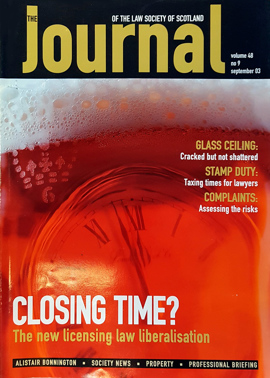Marquess of Queensberry rules
Many have heard of the Court of Arbitration for Sport (CAS), but few know precisely what it does, how to get there or what happens in its proceedings. Often in disputes of a sporting nature, it appears in the press reports as an oblique reference without any further explanation. Alain Baxter’s twin fight against the Federation Internationale de Ski and the International Olympic Committee (IOC) is a case in point.
What is it?
CAS is a private legal institution and was created in 1983, to secure settlements in sports related disputes. The Swiss Federal Tribunal (CAS is governed by Swiss law) recognises CAS as a real arbitral tribunal offering sufficient guarantees of independence and objectivity for its awards to be final and enforceable. Awards made by CAS have the same force as judgments pronounced by ordinary courts.
How do you get there?
It is important to remember that the CAS does not have automatic jurisdiction over sporting disputes. Jurisdiction must be prorogated to CAS. In 1994, 31 international sports federations (including the IOC) agreed to constitute the International Council of Arbitration for Sport and recognise the jurisdiction of CAS. This support combined with an increased number of contracts containing arbitration clauses recognising CAS’ jurisdiction and disciplinary procedures providing a right of appeal to CAS has resulted in it hearing an increasing number of disputes.
CAS entertains two types of dispute. First, using its ordinary arbitration procedure, the court resolves disputes arising from various legal relations between parties in which it has been agreed that CAS has jurisdiction. CAS does not have automatic jurisdiction and so such recognition must exist either in an arbitration agreement or the contract governing the parties’ relationship. Almost any sporting matter between anyone from individual athlete to television companies can result in ordinary arbitration proceedings before CAS. Examples are disputes regarding sponsorship contracts, television rights, undertakings by athletes, and contracts between athletes and managers.
Secondly, using its appeals arbitration procedure, CAS considers appeals from final decisions of sports federations and governing bodies. Again, with no automatic right of recourse, reference to CAS must exist in the sports bodies’ statutes or a specific agreement to arbitrate using CAS. Examples are disciplinary decisions regarding doping, qualification of athletes, official recognition of events and so on.
Difficulties can arise when the statutes of disciplinary bodies are not clear. There can often be language problems when a provision that may be clear in, say, the original French is meaningless when translated into another language. UEFA’s articles provide that any decision of a pecuniary nature may be open to challenge, but not sporting disputes. It is difficult to think of any sporting decision which does not have a pecuniary effect. CAS recognises such difficulties and can (and will) hold a preliminary determination regarding jurisdiction.
Where does it sit?
CAS is based in Lausanne, Switzerland, but can sit elsewhere if circumstances require it. For example, an office was opened in Salt Lake City for the XIX Winter Olympics, further to the IOC arbitration rules recognising CAS jurisdiction found in the athlete participation agreement. CAS also has offices in New York and Sydney.
Proceedings are generally heard before a tribunal of three, made up of a president and one arbiter chosen by each party, from a list published by CAS. Parties can either appear themselves or be represented. The procedural rules are simple and as the system is specifically for sports disputes, it is simple and flexible compared to ordinary court proceedings. Time limits can be shortened where the circumstances require it and proceedings are cheap compared to other proceedings. For example, in Alain Baxter’s dispute mentioned above, CAS specifically shortened time limits to ensure the skier could return to World Cup event skiing if his appeal was successful (as it was).
Commentary
The main disadvantage with CAS is that there is no automatic jurisdiction for sporting disputes and from the writers’ experience sporting bodies will often do their best to avoid the jurisdiction of CAS if they can. As CAS publishes its decisions in both case digests and online, the citation of the jurisprudence of CAS is increasing and its recognition is increasing. Indeed, CAS’ influence has become such that it is largely responsible for sports law becoming an international rather than localised jurisprudence.
For more information on CAS and latest CAS case law, see www.tas-cas.org.
Michael Nicholson and Bruce Caldow, Sports Law Practice Group, Harper Macleod
In this issue
- The truth is a terrifying commodity
- Last orders for drinks licences as we know them
- Inside the Nicholson Report
- The room at the top
- To protect and serve
- All change for stamp duty
- Get an honest day’s work for an honest day’s pay
- Facing up to threats of action – and learning
- How to make other people run your IT smoothly
- Client care goes live
- Praise on anti-money laundering efforts
- Sheriff’s notes not recoverable
- Restoration or castles in the air?
- Marquess of Queensberry rules
- Website reviews
- Book reviews
- Conveyancers asked to order early reports






